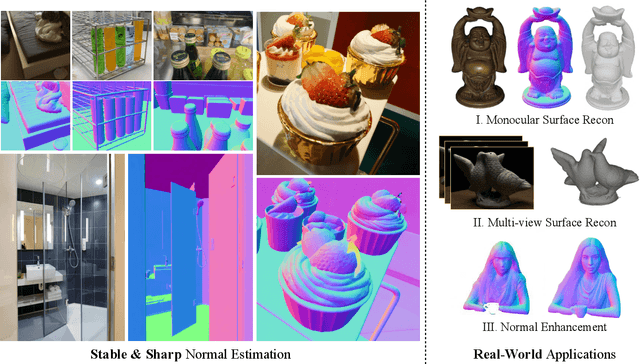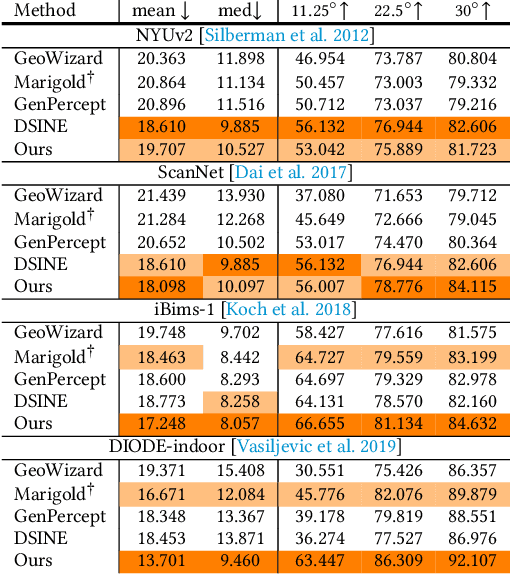Qi Zuo
PF-LHM: 3D Animatable Avatar Reconstruction from Pose-free Articulated Human Images
Jun 16, 2025Abstract:Reconstructing an animatable 3D human from casually captured images of an articulated subject without camera or human pose information is a practical yet challenging task due to view misalignment, occlusions, and the absence of structural priors. While optimization-based methods can produce high-fidelity results from monocular or multi-view videos, they require accurate pose estimation and slow iterative optimization, limiting scalability in unconstrained scenarios. Recent feed-forward approaches enable efficient single-image reconstruction but struggle to effectively leverage multiple input images to reduce ambiguity and improve reconstruction accuracy. To address these challenges, we propose PF-LHM, a large human reconstruction model that generates high-quality 3D avatars in seconds from one or multiple casually captured pose-free images. Our approach introduces an efficient Encoder-Decoder Point-Image Transformer architecture, which fuses hierarchical geometric point features and multi-view image features through multimodal attention. The fused features are decoded to recover detailed geometry and appearance, represented using 3D Gaussian splats. Extensive experiments on both real and synthetic datasets demonstrate that our method unifies single- and multi-image 3D human reconstruction, achieving high-fidelity and animatable 3D human avatars without requiring camera and human pose annotations. Code and models will be released to the public.
LHM: Large Animatable Human Reconstruction Model from a Single Image in Seconds
Mar 13, 2025Abstract:Animatable 3D human reconstruction from a single image is a challenging problem due to the ambiguity in decoupling geometry, appearance, and deformation. Recent advances in 3D human reconstruction mainly focus on static human modeling, and the reliance of using synthetic 3D scans for training limits their generalization ability. Conversely, optimization-based video methods achieve higher fidelity but demand controlled capture conditions and computationally intensive refinement processes. Motivated by the emergence of large reconstruction models for efficient static reconstruction, we propose LHM (Large Animatable Human Reconstruction Model) to infer high-fidelity avatars represented as 3D Gaussian splatting in a feed-forward pass. Our model leverages a multimodal transformer architecture to effectively encode the human body positional features and image features with attention mechanism, enabling detailed preservation of clothing geometry and texture. To further boost the face identity preservation and fine detail recovery, we propose a head feature pyramid encoding scheme to aggregate multi-scale features of the head regions. Extensive experiments demonstrate that our LHM generates plausible animatable human in seconds without post-processing for face and hands, outperforming existing methods in both reconstruction accuracy and generalization ability.
MulSMo: Multimodal Stylized Motion Generation by Bidirectional Control Flow
Dec 13, 2024Abstract:Generating motion sequences conforming to a target style while adhering to the given content prompts requires accommodating both the content and style. In existing methods, the information usually only flows from style to content, which may cause conflict between the style and content, harming the integration. Differently, in this work we build a bidirectional control flow between the style and the content, also adjusting the style towards the content, in which case the style-content collision is alleviated and the dynamics of the style is better preserved in the integration. Moreover, we extend the stylized motion generation from one modality, i.e. the style motion, to multiple modalities including texts and images through contrastive learning, leading to flexible style control on the motion generation. Extensive experiments demonstrate that our method significantly outperforms previous methods across different datasets, while also enabling multimodal signals control. The code of our method will be made publicly available.
AniGS: Animatable Gaussian Avatar from a Single Image with Inconsistent Gaussian Reconstruction
Dec 03, 2024



Abstract:Generating animatable human avatars from a single image is essential for various digital human modeling applications. Existing 3D reconstruction methods often struggle to capture fine details in animatable models, while generative approaches for controllable animation, though avoiding explicit 3D modeling, suffer from viewpoint inconsistencies in extreme poses and computational inefficiencies. In this paper, we address these challenges by leveraging the power of generative models to produce detailed multi-view canonical pose images, which help resolve ambiguities in animatable human reconstruction. We then propose a robust method for 3D reconstruction of inconsistent images, enabling real-time rendering during inference. Specifically, we adapt a transformer-based video generation model to generate multi-view canonical pose images and normal maps, pretraining on a large-scale video dataset to improve generalization. To handle view inconsistencies, we recast the reconstruction problem as a 4D task and introduce an efficient 3D modeling approach using 4D Gaussian Splatting. Experiments demonstrate that our method achieves photorealistic, real-time animation of 3D human avatars from in-the-wild images, showcasing its effectiveness and generalization capability.
StableNormal: Reducing Diffusion Variance for Stable and Sharp Normal
Jun 24, 2024



Abstract:This work addresses the challenge of high-quality surface normal estimation from monocular colored inputs (i.e., images and videos), a field which has recently been revolutionized by repurposing diffusion priors. However, previous attempts still struggle with stochastic inference, conflicting with the deterministic nature of the Image2Normal task, and costly ensembling step, which slows down the estimation process. Our method, StableNormal, mitigates the stochasticity of the diffusion process by reducing inference variance, thus producing "Stable-and-Sharp" normal estimates without any additional ensembling process. StableNormal works robustly under challenging imaging conditions, such as extreme lighting, blurring, and low quality. It is also robust against transparent and reflective surfaces, as well as cluttered scenes with numerous objects. Specifically, StableNormal employs a coarse-to-fine strategy, which starts with a one-step normal estimator (YOSO) to derive an initial normal guess, that is relatively coarse but reliable, then followed by a semantic-guided refinement process (SG-DRN) that refines the normals to recover geometric details. The effectiveness of StableNormal is demonstrated through competitive performance in standard datasets such as DIODE-indoor, iBims, ScannetV2 and NYUv2, and also in various downstream tasks, such as surface reconstruction and normal enhancement. These results evidence that StableNormal retains both the "stability" and "sharpness" for accurate normal estimation. StableNormal represents a baby attempt to repurpose diffusion priors for deterministic estimation. To democratize this, code and models have been publicly available in hf.co/Stable-X
An Optimization Framework to Enforce Multi-View Consistency for Texturing 3D Meshes Using Pre-Trained Text-to-Image Models
Mar 22, 2024



Abstract:A fundamental problem in the texturing of 3D meshes using pre-trained text-to-image models is to ensure multi-view consistency. State-of-the-art approaches typically use diffusion models to aggregate multi-view inputs, where common issues are the blurriness caused by the averaging operation in the aggregation step or inconsistencies in local features. This paper introduces an optimization framework that proceeds in four stages to achieve multi-view consistency. Specifically, the first stage generates an over-complete set of 2D textures from a predefined set of viewpoints using an MV-consistent diffusion process. The second stage selects a subset of views that are mutually consistent while covering the underlying 3D model. We show how to achieve this goal by solving semi-definite programs. The third stage performs non-rigid alignment to align the selected views across overlapping regions. The fourth stage solves an MRF problem to associate each mesh face with a selected view. In particular, the third and fourth stages are iterated, with the cuts obtained in the fourth stage encouraging non-rigid alignment in the third stage to focus on regions close to the cuts. Experimental results show that our approach significantly outperforms baseline approaches both qualitatively and quantitatively.
VideoMV: Consistent Multi-View Generation Based on Large Video Generative Model
Mar 18, 2024Abstract:Generating multi-view images based on text or single-image prompts is a critical capability for the creation of 3D content. Two fundamental questions on this topic are what data we use for training and how to ensure multi-view consistency. This paper introduces a novel framework that makes fundamental contributions to both questions. Unlike leveraging images from 2D diffusion models for training, we propose a dense consistent multi-view generation model that is fine-tuned from off-the-shelf video generative models. Images from video generative models are more suitable for multi-view generation because the underlying network architecture that generates them employs a temporal module to enforce frame consistency. Moreover, the video data sets used to train these models are abundant and diverse, leading to a reduced train-finetuning domain gap. To enhance multi-view consistency, we introduce a 3D-Aware Denoising Sampling, which first employs a feed-forward reconstruction module to get an explicit global 3D model, and then adopts a sampling strategy that effectively involves images rendered from the global 3D model into the denoising sampling loop to improve the multi-view consistency of the final images. As a by-product, this module also provides a fast way to create 3D assets represented by 3D Gaussians within a few seconds. Our approach can generate 24 dense views and converges much faster in training than state-of-the-art approaches (4 GPU hours versus many thousand GPU hours) with comparable visual quality and consistency. By further fine-tuning, our approach outperforms existing state-of-the-art methods in both quantitative metrics and visual effects. Our project page is aigc3d.github.io/VideoMV.
RichDreamer: A Generalizable Normal-Depth Diffusion Model for Detail Richness in Text-to-3D
Nov 28, 2023Abstract:Lifting 2D diffusion for 3D generation is a challenging problem due to the lack of geometric prior and the complex entanglement of materials and lighting in natural images. Existing methods have shown promise by first creating the geometry through score-distillation sampling (SDS) applied to rendered surface normals, followed by appearance modeling. However, relying on a 2D RGB diffusion model to optimize surface normals is suboptimal due to the distribution discrepancy between natural images and normals maps, leading to instability in optimization. In this paper, recognizing that the normal and depth information effectively describe scene geometry and be automatically estimated from images, we propose to learn a generalizable Normal-Depth diffusion model for 3D generation. We achieve this by training on the large-scale LAION dataset together with the generalizable image-to-depth and normal prior models. In an attempt to alleviate the mixed illumination effects in the generated materials, we introduce an albedo diffusion model to impose data-driven constraints on the albedo component. Our experiments show that when integrated into existing text-to-3D pipelines, our models significantly enhance the detail richness, achieving state-of-the-art results. Our project page is https://lingtengqiu.github.io/RichDreamer/.
 Add to Chrome
Add to Chrome Add to Firefox
Add to Firefox Add to Edge
Add to Edge